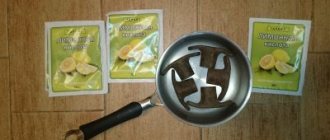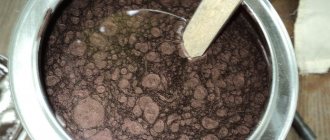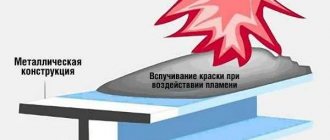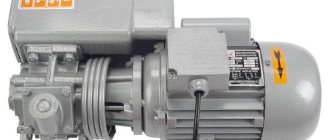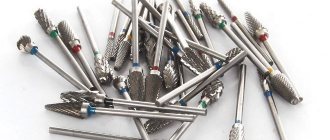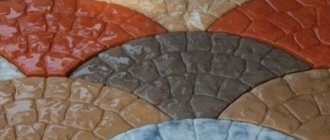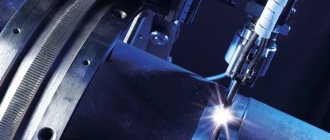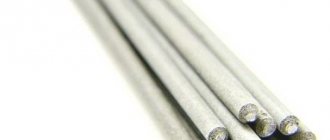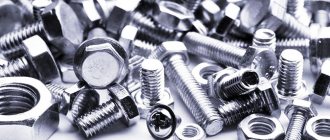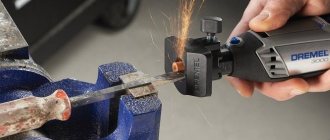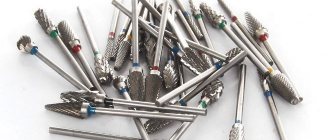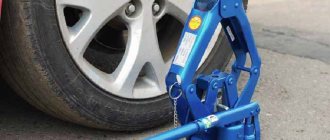Paint with a rust effect - application features
Recently, paint with a rust effect has become increasingly popular. We will also consider how to achieve such a color using two methods - imitate rusting or rust the metal using a natural method. We’ll talk further about how to make rust using different methods.
In this article, we do not take into account the natural method of metal rusting, which gradually begins to occur to it under the influence of the environment.
The process of natural rust can be accelerated through chemical reactions that cause corrosion of metal surfaces.
How to make brown?
The easiest way to get brown is to mix yellow, red and blue paints. That is, from primary colors. First, red and yellow are combined (to make orange), and then blue is added. All paints are taken in equal proportions.
Interesting materials:
What is the correct name for the headphone input? How to wear a bandage correctly when the kidneys are prolapsed? How to wear medals on a jacket? How to wear a weight loss belt correctly? What is the correct designation for phase and zero? How to properly treat tomatoes with copper sulfate? How to properly process walnuts? How to properly process dried apricots? How to properly process nuts? How to properly treat the soil with Fitosporin?
Rusting technique
Natural rust
Please note that first of all you should make sure that the metal that is to be rusted is susceptible to corrosion. Metals that contain iron are susceptible to rust. But many materials are resistant to rust, for example, chrome alloys or stainless steel. Cast iron and wrought iron will corrode well.
Copper acid solution
The instructions are:
Pour 60 ml of hydrochloric acid (also called hydrochloric acid) into a container. Be sure to use safety glasses and gloves during the process.- Dissolve just a little copper in acid (use coins or copper wire for this). The container should not be closed very tightly, since gases will form inside as a result of the reaction. Thus, after about a week we will obtain a solution that will provoke corrosive processes.
- Remove any remaining copper from the acid. Dilute the copper-acid solution with water in this proportion - for 1 measure of acid, add 50 measures of water.
- Strip the metal that you will rust from the paint and varnish material, and then wash the surface with a soapy solution.
- Apply a thin layer of acid to the metal surface. This can be done with a spray bottle or brush. Allow the material to dry in fresh air. At the same time, as before, one should not forget about safety measures (goggles and gloves), as well as good ventilation of the room.
- After an hour, noticeable rust will begin to appear on the metal surface. It is not so important to wash off the solution, because it will gradually evaporate naturally. If the resulting rust is not sufficient, the surface can be treated again.
Let's consider another method.
Vinegar solution and bleach
This method is best suited for metals based on tin or iron. A prerequisite is that the surface should not be primed or even coated with sealants.
The instructions are:
- Mix one measure of vinegar and two measures of bleach in a container.
- Stir the metal in the container so that it is completely damaged. Wait about ½ hour, and after this period, rust will begin to appear on the surface.
- Wipe the material with a rag.
- Until the item is completely dry, you should avoid direct contact with it to avoid damaging your skin with chlorine.
- Fix the rust with primer. The easiest way is to use a primer in an aerosol can.
What other ways are there?
Other methods
In addition to paint with a rust effect on metal, there are other very popular methods for accelerating corrosion processes. But there are other methods. Rusting with hydrogen peroxide + salt:
- Pour the peroxide into a container - it is advisable to use a spray bottle, because this method will be the easiest to apply the liquid to the surface of the material.
- Spray metals well.
- Sprinkle the wet surface with salt. The metal will begin to rust almost immediately, and the intensity of the rusting will depend on the amount of salt.
- Let the metal dry in the fresh air. The surface cannot be wiped until it dries, as rusting will be very uneven. You can wipe the surface only after it has completely dried.
Another rusting method using vinegar and hydrogen peroxide:
- Clean the surface (if necessary).
- Spray peroxide over the surface from a spray bottle.
- Spray vinegar over the surface of the metal.
- Wait a few hours for rust to begin to appear.
Rusting with salt and lemon juice:
- Mix four measures of lemon juice and one measure of table salt.
- Treat the cleaned surface with the solution, and soon traces of rust will begin to appear.
Now a little about artificial methods.
Imitation rust
In order to achieve the rust effect, the material must be damaged. You can imitate rust, and at the same time you can give a rusty look to metal and other types of material, in particular wood.
Rust paint
A rusty tint will appear when yellow, red and brown pigments are mixed. You can also add a little blue color - this will give the coating depth and brightness. There is a natural pigment that, without mixing different colors, will make it possible to obtain a rusty tint. This pigment is called ocher (another name would be red lead), which is a mixture of iron oxide hydrate and clay. Natural ocher will not be an independent type of paint, and it is only a component that is added in varying quantities to paints and varnishes (enamels and paints) and primers.
In addition to this component, paints also contain other substances. The pigment has the following characteristics:
- The coverage rate is 60-80 grams per square meter.
- The oil capacity will be 25-35 grams per 0.1 kg of substance.
- The pH of the water extract is from 7 to 8.
Ocher has excellent resistance to aggressive chemical substances (acids, organic solvents and alkalis), as well as resistance to moisture and light.
Imitation film
It is not necessary to buy paint with a rust effect if you can give the metal a rusty look using a special film. Below are instructions for use:
degrease the surface with alcohol.- Try the film elements onto the treatment surface.
- Moisten the metal with a special spray bottle, and the film should be glued to the wet surface better.
- Tear off the film from the backing.
- First glue the middle part of the canvas, and then smooth the edges over the surface.
- Dry the glued film with a hairdryer.
There is one more interesting method left.
Corrosion of metal
In this part of the article we will tell you how to make rust by accelerating the corrosion processes. This can be done through a chemical reaction, which will provoke rapid rusting of the material.
It must be taken into account that corrosion develops only in those metals that contain iron. However, even in this case, not all iron-containing metals can rust easily. For example, you should not mess with chrome alloys or stainless steel. But ordinary steel and cast iron rust very quickly.
To carry out a chemical reaction, you will need to prepare a copper-acid solution. A mixture of bleach and vinegar is also effective.
Copper acid solution
We prepare the chemical solution as follows:
Note! There is no need to rinse off the hydrochloric acid solution, as it will evaporate after some time in any case.
Bleach and vinegar mixture
This method is best used for rusting materials with the addition of tin. There is an important clarification: the metal cannot be primed or sealed before applying the solution.
Other rusting options
You can provoke corrosion using hydrogen peroxide and salt as follows:
Another way to create a rusty color on metal is to treat the metal with vinegar and hydrogen peroxide:
And finally, the metal can be rusted with a lemon-salt solution:
Description of materials
Many compounds that can be used to treat corroded metal are included in the group of water-dispersed (water-diluted) primers and primer paints. The latter include phosphoric acid, which is known to bind corrosion. Painting with these solutions allows you to create a polymer film on the structure - an excellent barrier from the aggressive influence of the external environment.
Rust effect on wood furniture
Imitation of rust can be done not just on metal, but even on wood. You will need two types of paint, table salt, sandpaper and varnish composition. One of the paints should be in the color that is most similar to rust. The second paint will act as the main paint, and it should match the furniture and other accessories inside the room. Before applying rust-colored paint, you should clean the surface of the wood from any types of flaws.
You can also varnish the wood. Next, paint the furniture with rust paint and wait until the surface dries a little. Apply a layer of table salt to the surface that is not completely dry. When the surface on which there is salt dries, apply the base paint. Wait for the surface to dry, and then remove the salt using fine-grained sandpaper. If you don't remove all the salt, it will create a slightly roughened effect that will enhance the rusty color. The last step is to treat the wood with a protective layer of varnish. The rust effect will give any product a completely unique and unique appearance.
Moreover, you can do all this even with your own hands. The main thing in the process of work will be to comply with the technological process and adhere to protective measures, since in most cases it will be necessary to work with chemicals that are unsafe for health.
A little history
ATTENTION! A completely simple way to reduce fuel consumption has been found! Don't believe me? An auto mechanic with 15 years of experience also didn’t believe it until he tried it. And now he saves 35,000 rubles a year on gasoline! Read more"
The direction of “imitation rust” is a special tuning technique that gained popularity in Russia about 10 years ago. It is worth noting that its roots come from America, so painting a Japanese car “red onion” is not entirely correct.
The key feature of this style is the presence of a rusty body or its high-quality styling to match it. A similar effect can be achieved by using one of such methods as highlighting the paint layer, stripping to the ground or even to the metal, through corrosion.
Despite the fact that the body is given an aged look, these cars are equipped with rather expensive wheels, which also emphasize the antiquity. In this case, the rubber rim must be painted white. Elements such as the suspension, engine and underbody are brought to perfect condition through certain cleaning and grinding procedures. As for the interior, it is decorated solely at the request of the owner.
Film
If you want to try the Rat Look style on your car, but do not want to spoil the body with natural rust, then there is a film with a corrosion effect especially for you. It is important to understand that the development of a sticker must be carried out individually for your car in order to repeat all the indentations and bends of the body.
The question of how to paint over rust on a car with your own hands is easy to solve. In the article you can see how to do this correctly at home. And step-by-step photos will help you do the job better.
Helpful information
Tips for painting a car:
- The composition should not be applied to a loose layer of rust; it must be cleaned off.
- If the paint contains a primer, then it is used as a mono product. The number of layers must be at least 3.
- The coating can only be applied to a dry surface.
- When painting a large area, the paint is applied in stripes. In this case, each line must overlap the previous one.
You can learn a lot of important and useful information about the methods and methods of removing rust from a car here.
Work algorithm
Before painting a rusty metal structure, it must be prepared. The entire cycle of work operations can be arranged in the form of separate stages:
- Manipulations aimed at mechanical cleaning of the surface. Before painting a corrosive surface, it must be cleaned, otherwise the durability of the applied paintwork will be very low. A metal brush or a special drill attachment is suitable for the job;
- Smoothing the cleaned base with a sandblasting machine or any grinding device. Automation of the process speeds it up; manually grinding a structure is a tedious and time-consuming task;
- Rust can be removed with chemical compounds that dissolve it. These are many types of strong acids and alkalis.
Important: when working with chemical reagents, the master must follow safety precautions.
- Another option is to transform rust into a durable film. For this purpose, chemical converters are used, produced in the form of suspensions and emulsions. The drugs in this series have a significant disadvantage - the ability to change the color of the metal finish;
- After cleaning the surface, it should be degreased. If this step is omitted, the adhesion of the metal base will be low. It is good to wash rust with detergents containing citrus extracts. Sometimes wet cleaning causes rust stains that can be easily removed with a regular solvent;
- Priming a metal product. For this purpose, an inhibitor primer with iron oxide or zinc chromate is used. The product is applied strictly according to the instructions that come with the bottle. Advice: many users do not recommend using a sprayer for these purposes; manual application guarantees 100% filling of the metal pores;
- Final painting. Matte or glossy paint is applied in two layers. A roller or wide brush is used. Manual painting is of higher quality, since all areas are guaranteed to be covered with a protective composition.
As can be seen from the procedure described above, even a non-professional craftsman can paint rusty metal. Consistent implementation of key steps will inevitably lead to the desired result - the metal structure will be reliably protected from corrosion for some time.
Do you have a car and need money? Work as a courier using the Yandex.Pro application and earn up to 2,800 rubles per day! More details at the link.
- Convenient schedule.
Work a few hours a day or work a full shift. - Fast start.
You can start placing orders on the same day that the documents are completed. - Fixed salary.
The average courier earnings are 2800 ₽ per day before deducting the partner’s commission - Clear terms.
Parcels are insured and limited in weight: up to 10 kg for pedestrians and up to 20 kg for auto couriers. No work experience or special license required.
We imitate rust using shellac varnish, talc and stain
I did this master class on simulating rust quite a long time ago and I know for sure that many decorators of various directions successfully use this method in their works, which I am certainly very happy about!
Since I am also an experimenter and I have a lot of perseverance, as a result of trial and error I found an ideal (at least for myself) and quite simple way to imitate rust; moreover, the result is very difficult to distinguish from real rust and the coating turns out to be quite durable ! Until now I have not published this master class at the Masters Fair, I am correcting myself
